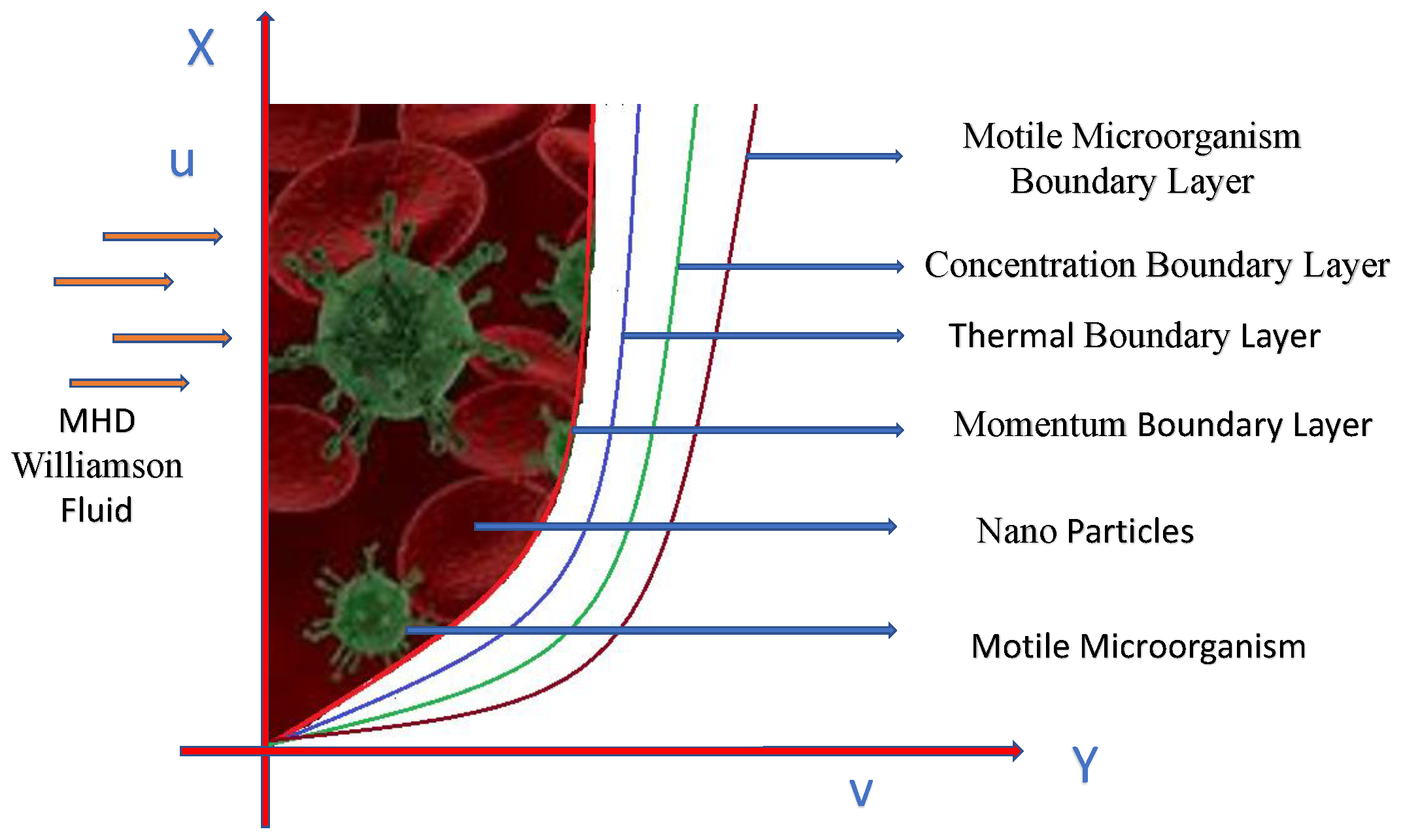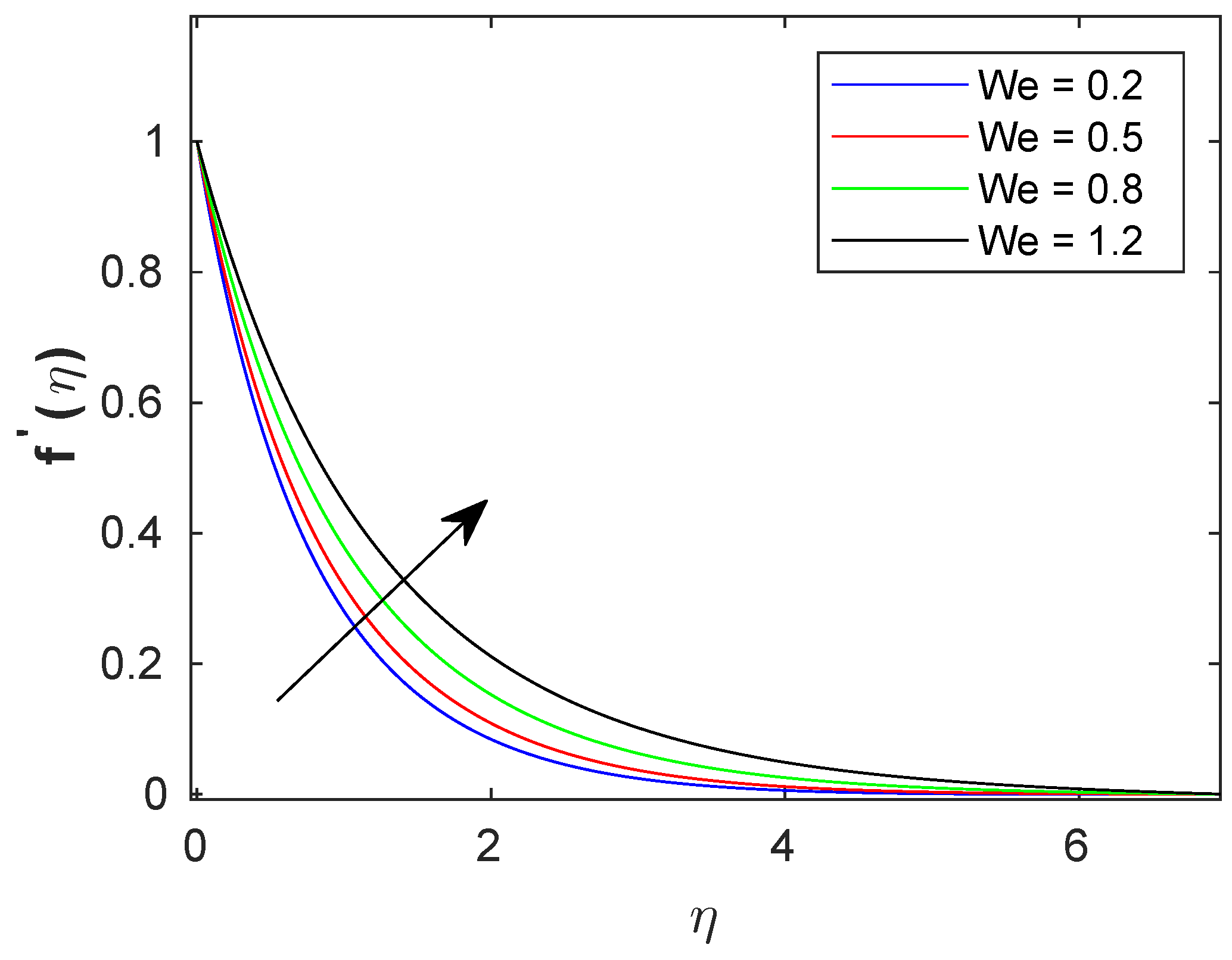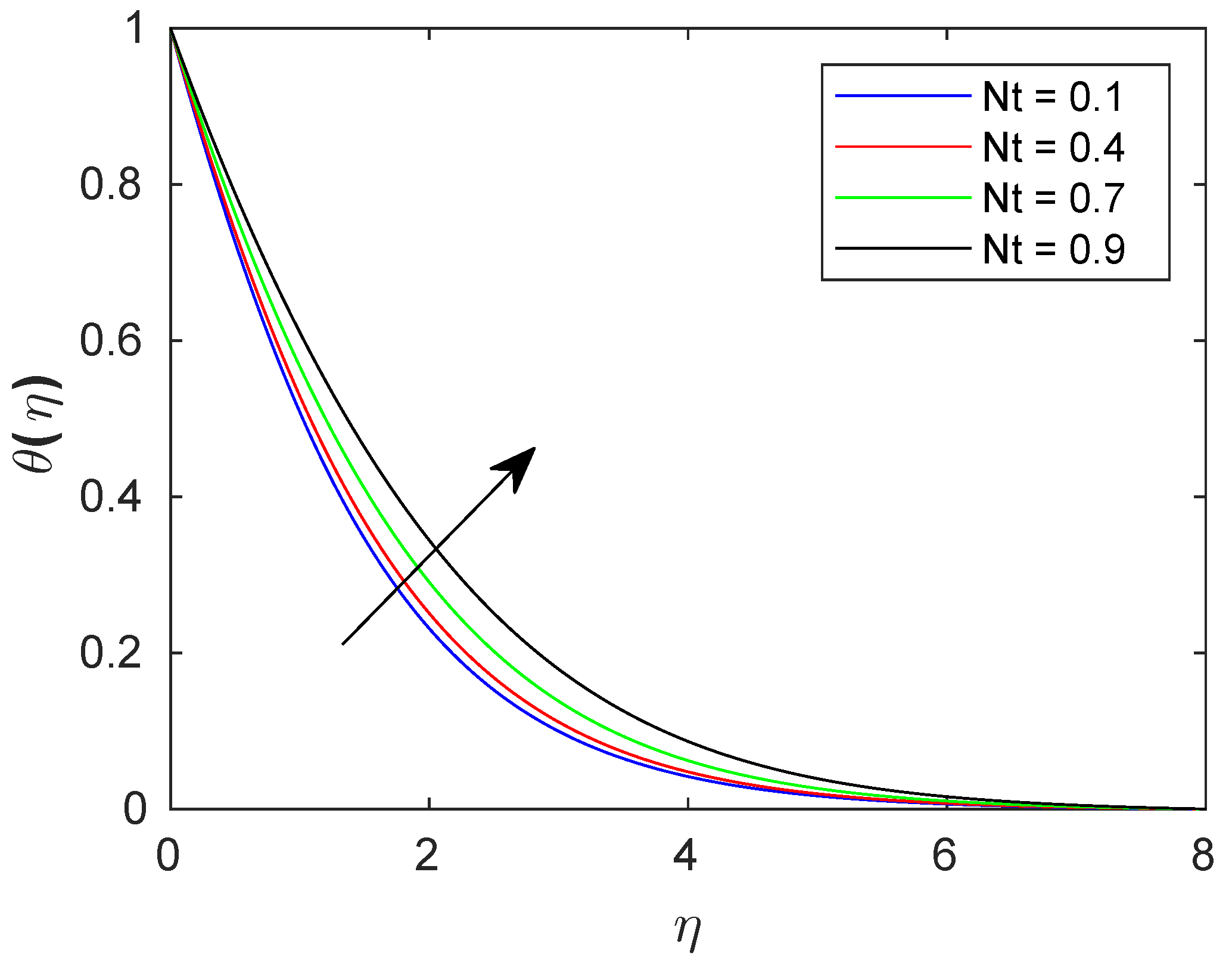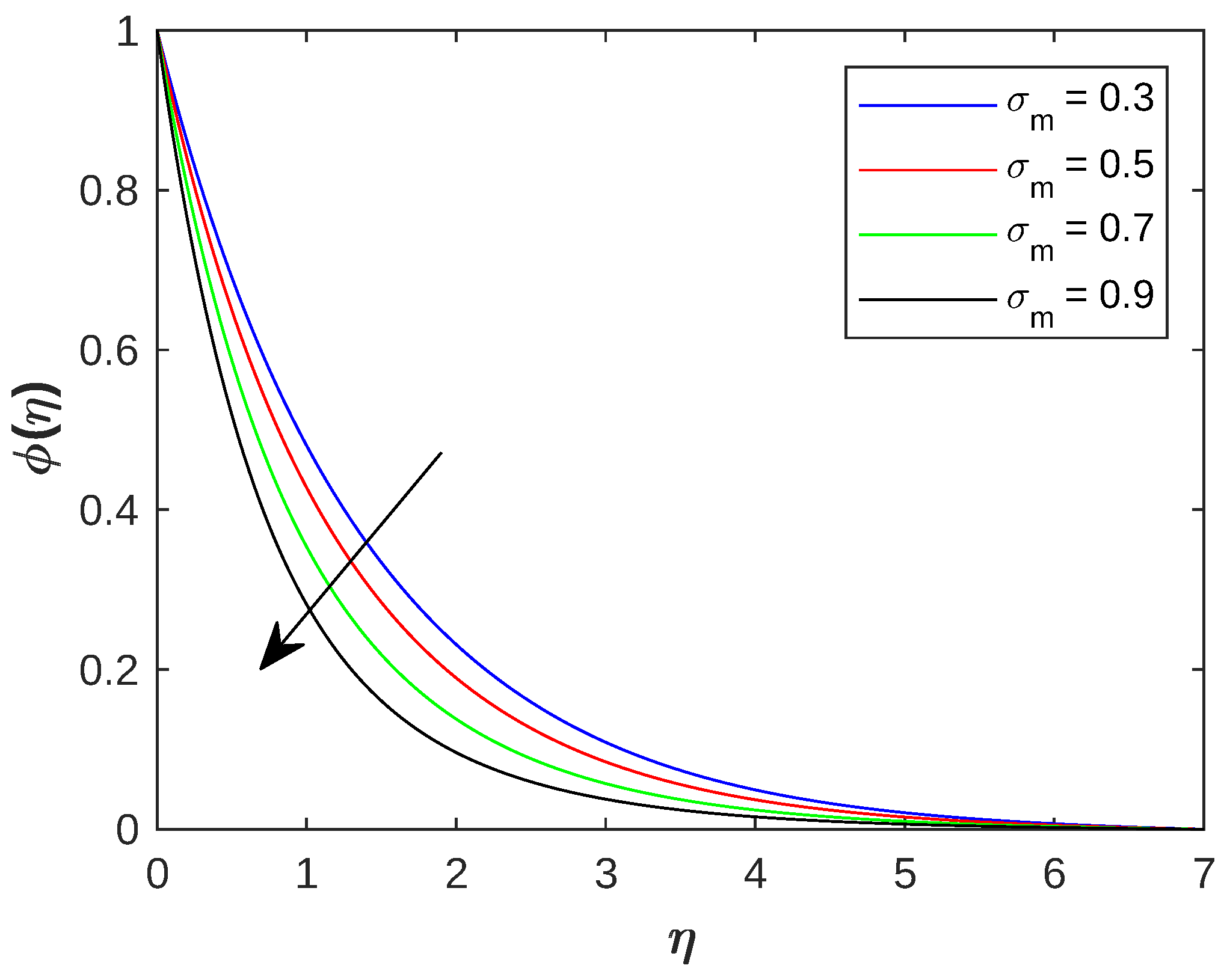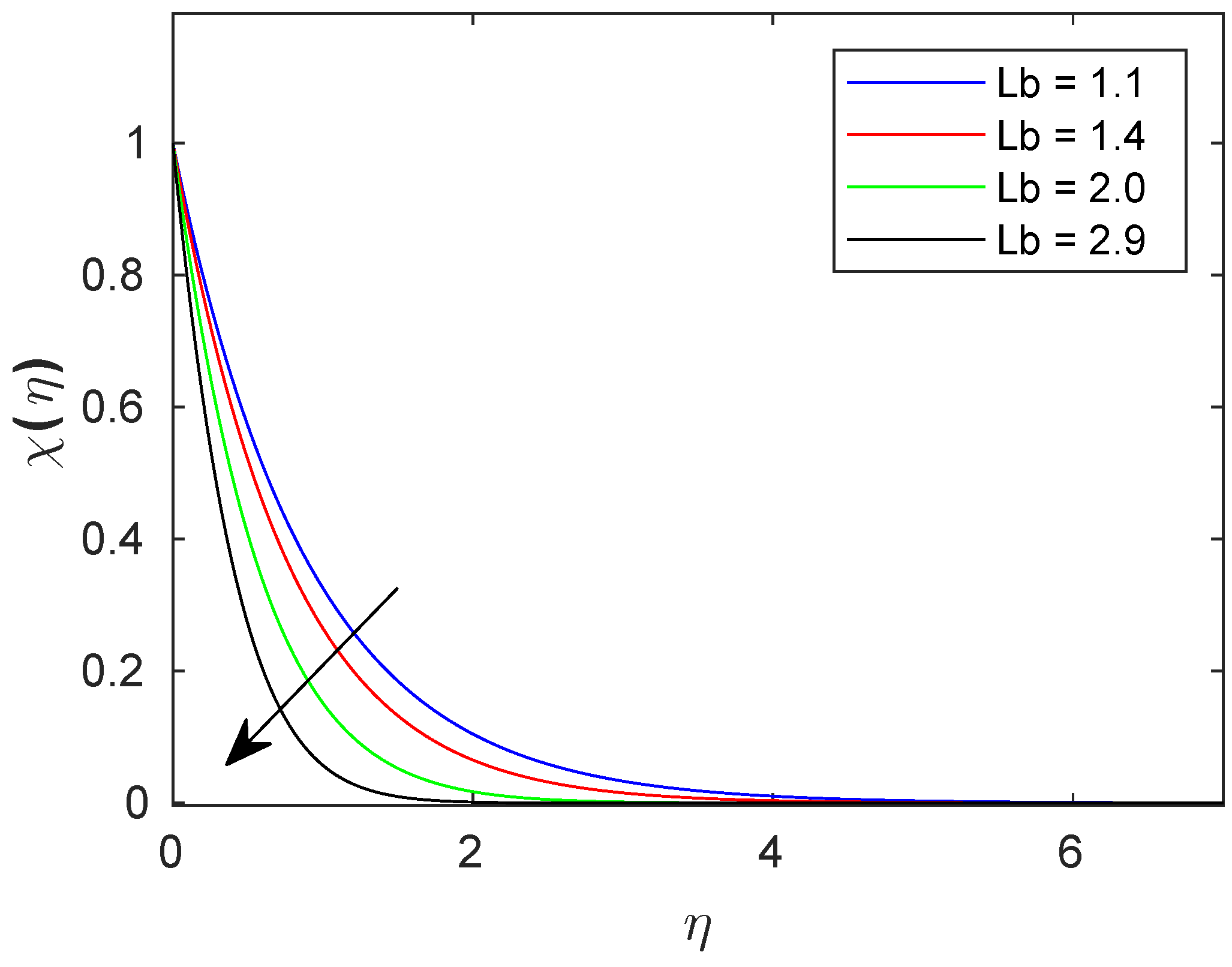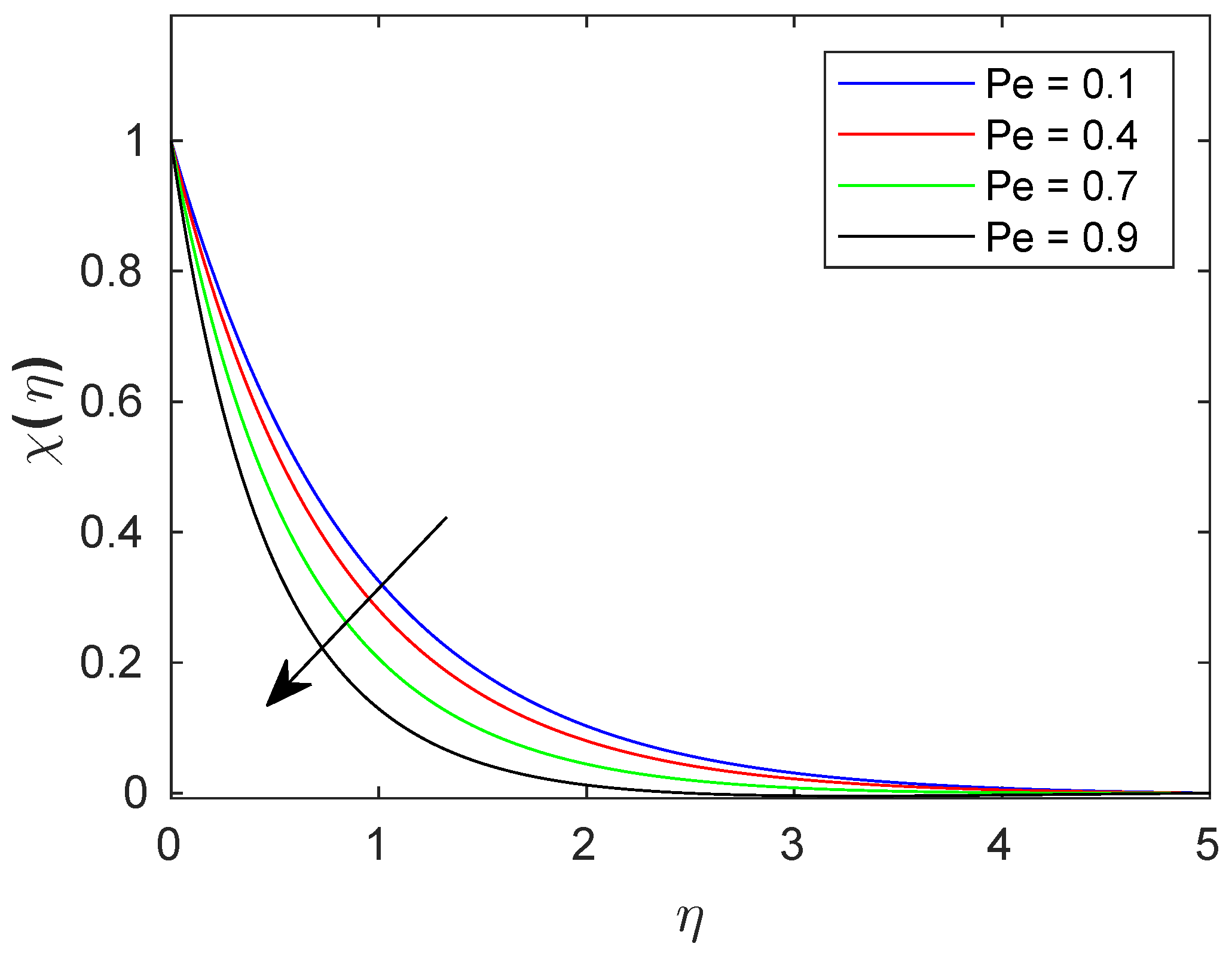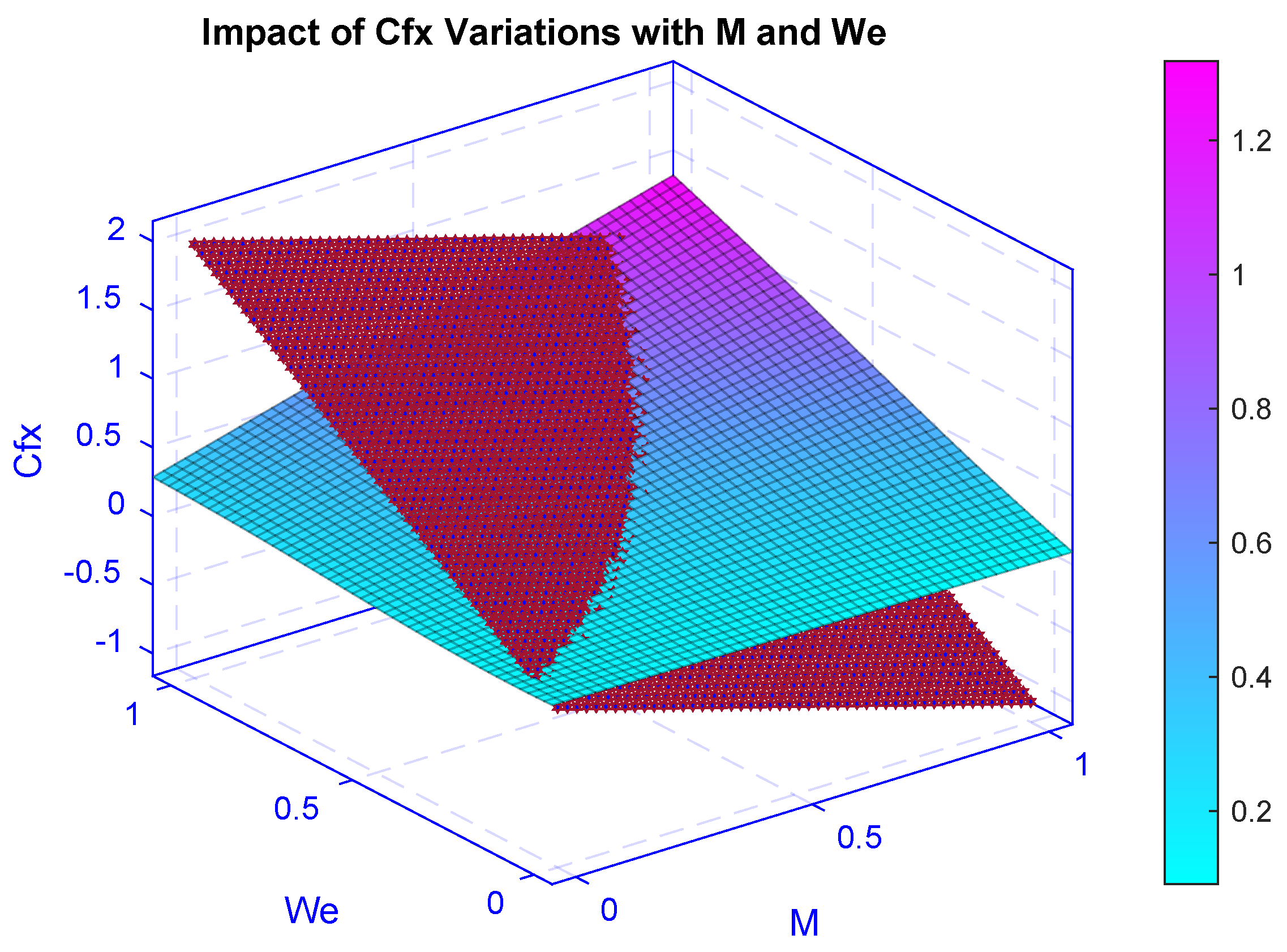1. Introduction
The present research explores thermal radiation’s impact and the phenomenon of bio-microorganisms in MHD Williamson non-Newtonian fluid flow across a symmetrically stretching sheet. The analysis of non-Newtonian fluid flow over symmetrical related features has captured the curiosity of researchers owing to the increasing ability to transmit heat and broad application in the scientific and technical industry sectors. The evaluation of heat and mass transfer on fluids over symmetrically extending surfaces with the effects of chemical reactions plays an essential role in solar systems, heat exchangers, nuclear reactors, etc. The symmetrical idea of fluid flow over a stretched sheet was developed by academics and researchers, in particular [
1,
2,
3,
4], to study the transfer of heat to obtain an exact solution.
Microbe motion in a solution is the main factor of the bio-convection process. Microbes react to various chemical inputs and another element’s density by migrating in particular directions. Distortion in the stimulus’s instruction for the contrary tandem determines positive and negative microbe motility. Gyrotactic microorganisms usually exhibit movement prompted by a density differential, as it has been shown that bacteria climb up in solution cells. The only strategy used in bio-remediation to remove environmental toxins from a site is to deliver microorganisms present. Kuznetsov [
5,
6] initially suggested a study on the significance of gyrotactic and oxyntic bacteria.
On vertical plates with Navier slip and a magnetic field, Khan et al. [
7] looked at the nanofluid produced by gyrotactic bacteria flowing in its outermost layer. For an upper surface of a paraboloid of revolution, Makinde et al. [
8] addressed the effect of the magnetic and nonlinear thermal radiation field on the flow of a bio-convection MHD nanofluid. A computational analysis of gyrotactic microorganism-containing radiative nanofluid in three dimensions with an isotropic slip, binary chemical reaction, and activation energy was described by M. Ramzan et al. [
9]. Zhao et al. [
10] developed microorganisms that rotate on a nanofluid and used them to study stability. In addition to the earlier attempt, researchers have described the applications of bioconvection gyrostatic microorganisms in [
11,
12,
13,
14,
15,
16]. These studies highlight the significance of microbial motion for mixed fluids in biological sciences, biogas production, cancer therapy and prevention, and bioremediation procedures.
Chu et al. [
17] studied the impact of mobile microorganisms, activation energy, thermal diffusion, Brownian motion, and chemical reaction on the flow of a bio-convection MHD fluid towards an extended sheet. The activation energy for chemical reactions and microbiological activity in a mathematical model of bio-convection flow was designed by Mlamuli Dhlamini et al. [
18]. Naresh Kumar et al. [
19] created computer methods and programs in bio-medicine for irreversibility analysis of a blood nanofluid moving through an interface that squeezes and has activation energy.
Prandtl nanofluid activation energy and chemical reactions over a vertical surface with bio-convection flow were analyzed by Zafar et al. [
20]. A. Shahid et al. [
21] investigated the temperature-dependent viscosity and estimated the Arrhenius kinetic magnetized bio-convection nanofluid flow numerically. Sachin Shaw et al. [
22] studied the impact of the Prandtl number along with the linear, nonlinear, and quadratic thermal radiations on the hydromagnetic flow and thermal interpretations of cross-hybrid nanofluids. Satya Subha Shree Sen et al. [
23] simulated entropy, heat, and mass transmission using MHD and nonlinear radiation in a water–EG-based hybrid nanoliquid flow. I.S. Oyelakin et al. [
24] developed a Casson nanofluid, utilizing the bivariate spectral quasi-linearization method to optimize entropy production for unstable stagnating flows across a stretching sheet with binary chemical reaction and Arrhenius activation energy.
Applications of pseudo-plastic boundary layers of Williamson fluids utilized in the industrial sector include high molecular weight polymer materials and emulsion-coated polymer sheets used in extrusion, photographic films. The behavior of pseudo-plastic fluids [
25,
26,
27,
28,
29] has been studied using a variety of non-Newtonian models, including the Cross model, Ellis model, Carreaus model, power law models, etc. On the other hand, a significant amount of study has existed on the many ways Williamson fluid flows through an expanding surface in which MHD appears.
The implementation of Navier-Stokes equations expressed as PDEs permits the development of the ultimate framework for problems needing optimal fluid flow. Meanwhile, to implement a persistent spreadsheet with adjustable wall temperature for the problem of heat transmission and flow over a power-law fluid, these PDEs are solved using various techniques. A boundary layer analysis was performed by Hassanien et al. [
30]. S.Sreenadh et al. [
31] discussed the impact of slip and heat transfer on a Williamson fluid’s peristaltic pumping in an inclined channel. C. S. Raju et al. [
32] established the relationship between the effect of a heat source’s temperature and the Williamson and Casson fluid flows of a stretched sheet of material. A. Shahid et al. [
33] observed the activation energy for an exponentially temperature-dependent MHD nanofluid flow across a porous panel. The effects of Sorbet on the MHD movement of the Jeffrey fluid on a porosity movable surface were investigated by Pramod Kumar et al. [
34].
Shah N. A. et al. [
35] discovered the solution of convection flows over a vertical plate with increasing wall temperature and chemical-based reaction. Lou. Q. et al. [
36] explored the effects of the Coriolis force on the dynamics of an MHD rotating fluid under the impact of the Lorentz force. Most of the scientific literature has utilized the premise that factors involved in fluids such as conductivity, diffusivity, and viscosity are constant discovered by Salahuddin T. et al. [
37]. Anwar Shahid et al. [
38] established a nonlinear stretching surface that induces Casson polymeric flow with various convection radiative flux and non-Fourier thermal relaxation effects. Hayat et al. [
39] constructed a chemical-based non-Newtonian fluid and looked into a numerical solution for the computer simulation of Williamson fluid heat transfer with slippage impact on peristaltic pulsing along a stretched channel. Rajender et al. [
40] examined the Williamson fluid boundary-layer flow passing through an exponentially indirect stagnant state point close to a stretching object impacted by viscous dispersion.
Brownian motion and thermophoresis diffusion in a Williamson fluid flow across a symmetrically stretched sheet was studied by Muhammad Imran Asjad et al. [
41]. As the outcome, they found that the motile microorganism profile increased with the bioconvection Rayleigh number
and decreased with the bioconvection Lewis number
and Picklet number
. This recent study into the thermal transportation of fluid flow through several structures is depicted in
Figure 1. The skin friction coefficient is reduced by raising the value of the Williamson parameter
and suction/injection parameter
s, whereas it is increased by increasing the magnetic parameter
M. The outcome of this result was depicted by K. Ahamed et al. [
42]. As
rises, the rate of heat transfer increases, a result demonstrated in Ishak [
43] and Goud et al. [
44]. The primary objective of the current investigation is to determine whether gyrotactic auto-motile microorganisms can reduce the likelihood of precipitation by incorporating bio-convection and heat radiation into Williamson MHD fluid flow. These critical features provide essential advantageous heat mobility to the heat exchange processes of many modern technologies that have the potential to benefit from their inclusion. A simplified version the flowchart of the proposed solution method is highlighted in
Figure 2 to provide more clarity.
The majority of researchers looked into connections between analytical and numerical outcomes. This review task advanced by carrying out a provision in two different ways. The first implemented the BVP4C solver in MATLAB software to execute the computational approach, and the second followed the BVP4C solver by employing regression analysis with machine learning techniques. The four reamining sections of this paper are as follows: flow analysis, solution approach, results and discussion, and concluding remarks and final assessment of the results of the calculations made using machine learning.
2. Flow Analysis
The non-Newtonian MHD Williamson fluid flow across a symmetrically stretching sheet expanded along the x-axis and y-axis is assumed to be normal to the velocity . The flow region of a magnetic field moves in the y-axis. The non-Newtonian base fluid contains a random spread of nanoparticles and microbes. Thermal radiation is taken into account, and bioconvection occurs in the movement of microorganisms with the two-dimensional velocities u and v along the x and y directions.
The mathematical frameworks of the governing equations are the continuity, momentum, energy, concentration, and bio-convection equations formulated in [
41,
44,
45,
46].
According to [
41,
44,
45,
46], the boundary conditions are as follows:
Now, we introduce
Equation (
3) is expressed as the Rosseland approximation [
44].
We now introduce the similarity transformation [
41] listed below:
After applying the similarity transformation in Equations (1)–(5), Equation (
1) is satisfied identically; the transformed ODE equations are provided below in Equations (10)–(13).
The end point becomes
The overall contribution includes many parameters that are connected; these are
Here, M denotes the parameter of the magnetic field, is a non-dimensional parameter of Williamson fluid, s represents the parameter of suction () and the parameter of injection (), constitutes the parameter of mixed convection, means the Brownian motion factor, indicates the factor for the Buoyancy ratio, is the Rayleigh number of bio-convection, is the factor of thermophoresis diffusion, depicts the dimensionless rate of the reaction, E indicates the non-dimensional activation energy, K specifies a parameter of radiation, describes the bio-convectional difference parameter, stands for the distinct parameter of temperature, denotes the Schmidt number, represents that Peclet number, is the biological convection Lewis number, and indicates the Prandtl number.
The outermost wall shear stress, the heat flux, the mass flux, and the motile microorganism flux are represented as the coefficients of the skin friction (
), Nusselt number (
), Sherwood number (
), and motile microorganisms (
).
The shear stress along the stretched surface is provided by the symbol
, the temperature flow is represented by the symbol
, the symbol mass flux is
, and the symbol motile microbial flux is
in Equation (
17).
In the non-dimensional structure, the skin friction factor is
Applying Equations (
7), (
9) and (
14), the following result is obtained:
where
.
3. Solution Approach
In this evaluation phase, two distinct categories of problem solving techniques are demonstrated, with the initial numerical approach followed by the use of machine learning algorithms. The BVP4C solver in the MATLAB assemblage is used to execute the numerical solution procedure. The machine learning techniques appear in multiple linear regression. The numerical values of the flexible microorganism (), Nusselt number (), Sherwood factor (), and coefficient of skin friction () among the various flow conditions influencing each of them were calculated.
3.1. Numerical Approach
In this portion, the numerical techniques are illustrated. The nonlinear ODE Equations (
10)–(
13) are processed through numerical computation using the MATLAB software application BVP4C with a set of boundary constraints supplied by Equation (
14).
To solve boundary value constraints for ordinary differential equations, L.F. Sham-pine et al. [
47] looked at BVP4C handled in MATLAB. I. Gladwell et al. [
48] created the MATLAB program to be able to solve ODEs. Y.M. Chu et al. [
49] extensively analyzed the MATLAB program BVP4C package to solve nonlinear ordinary differential equations.
With regard to the three-stage Lobato 3A formula, Umair Khan et al. [
50] previously suggested a novel strategy using the finite difference method as the foundation for this BVP4C package, with a system of first-order ODEs created from the upper third-order and second-order realizable non-dimensional versions of ODEs for use with the BVP4C technique.
Applying the new variables is considered as
Substituting these variables in the dimensionless form of higher-order ODEs, these ODEs are converted into first-order ODEs.
and the boundary conditions are
The computational BVP4C method is used to implement and solve the system of first-order ODE Equations (
21)–(
29) and the corresponding boundary conditions in Equation (
30). This approach requires a preliminary estimation at the mesh point. The outcomes are presented in the higher order form, which is an advantage of this method.
The proposed
Table 1 demonstrated the numerical results producing better optimization results than those found in earlier articles [
41,
42] for the comparison of the skin friction coefficient.
Table 2 displays the numerical results, delivering more optimization than the results previously included in earlier articles [
41,
43,
44] for the comparison of Nusselt numbers. The results are extremely accurate, displaying outstanding harmony and exceeding the information that is already present in the available sources that were used.
The various physical parameters involved in particular M denotes the parameter of the magnetic field, constitutes the parameter of Williamson fluid, K specifies a parameter of radiation, means Brownian factor, points out diffusion of thermophoresis factor, denotes the Schmidt number, stands for Buoyancy ratio factor, depicts the dimensionless rate of reaction, E indicates non-dimensional activation energy, the Rayleigh number for bio-convection is , the Lewis number for bio-convection is , and the Peclet number is . Physical parameters, including the Nusselt number (), the Sherwood number (), the coefficient of skin friction (), and flexible microbe fluctuation () were calculated. Additionally, a profile of the temperature, concentration, velocity, and motile microorganisms are included in the present instance.
3.2. Machine Learning Approach
3.2.1. Description of Dataset
The branch of artificial intelligence (AI) described as machine learning (ML) analyses data that allow computers the ability to learn new ideas and improve their performance. A model is improved by machine learning algorithms using training data, known as sample data, by generating predictions or judgments without being explicit. In addition to their amazing capabilities, mathematical computation models based on machine learning (ML) created by Palash Sharma et al. [
51] have recently developed and are popular among professionals. Regression and classification ML techniques come in numerous varieties. In the current article, multiple linear regression analysis is executed. After analyzing the development of ML models in fluid flow, multiple linear regression was implemented in this study to predict the physical features of fluid flow [
52,
53,
54]. Nonlinear radiated magnetized unsteady wedge dynamical solution optimization using response surface methodology gradient descent is a machine learning technique studied in [
55]. The physical variables of the magnetic field parameter, Williamson fluid parameter for the factor of skin friction, Prandtl number, thermophoresis diffusion for the Nusselt number, Schmidt number, Brownian motion factor for Sherwood number, bio-convection Lewis number, and Peclet number for movable microorganisms were used to predict the skin friction coefficient, Nusselt number, Sherwood number, and motile microorganisms by employing multiple linear regression. Data were extracted from the numerical simulation sample. The accuracy was observed utilizing the data points that were evaluated.
3.2.2. Multiple Linear Regression Algorithm (MLR)
The importance of regression analysis lies the analyzing relationship between different variables and then forecasting the future traits of this relationship. There are two types of linear regression evaluation, namely, simple linear regression and multiple linear regression. In this section, we provide an overview of multiple linear regression (MLR) algorithms. MLR is performed based on the strong correlation between two or more response variables and one prediction variable. The assumptions behind multiple linear regression are identical to those of basic linear regression. The forecasting accuracy is rather constant across the response variable’s range of values. Because the observations in the datasets were obtained using accurate statistical sampling approaches, there are no unrecognized connections between the variables. It is critical to ascertain whether any of the response variables in multiple linear regression are related to one another before developing the regression model. The data are distributed normally. The prediction line is straight.
Multiple linear regression is calculated as follows:
Here, the response variables are , the prediction variable is y, the constant term represents the intercept of the regression line on the vertical axis, and the regression coefficients reflect the slope of the regression lines , and the random error e is used to describe the response variables that affect the prediction variable. The parameter evaluation subsequently determines the accuracy and regression equation.
The prediction equations of the skin friction coefficient, Nusselt number, Sherwood number, and motile microorganisms are presented below.
4. Result and Discussion
Our endeavor focused on the problem identified by Ahmed et al. [
42] and Muhammad Imran Asjad et al. [
41]. The values of the skin friction are provided in
Table 1, displaying the equivalent outcomes for skin friction effective performance along with the impact on the magnetic field parameter
M, the Williamson fluid parameter
, and the suction/injuction parameter
s. The numerical algorithm supported by the analysis carried out around the equivalent outcomes for the Nusselt number, along with the impacts on the parameter of radiation
K, parameter of the magnetic field
M, and the Prandtl number
determined by Ishak et al. [
43], Goud et al. [
44], Muhammad Imran Asjad et al. [
41], and the already available computational findings, are generally consistent with one another, as shown in
Table 2.
The preceding stage of the investigation focused primarily on changes in the velocity appearance, temperature description, concentration outline, and microorganism features. Additionally, the motile microbes, Nusselt quantity, Sherwood number, skin friction factor, and other physical characteristics produced the outcomes. It was established that the machine learning component of multiple linear regression, which incorporates additional data from the factor of skin friction with the parameter of the magnetic field with the Williamson fluid, Nusselt number with the Prandtl number and thermophoresis diffusion, Sherwood number with the Schmidt number and factor of Brownian motion, and mobile bacteria with the bio-convection Lewis number and Peclet number, all especially incorporate additional data derived from them. The originality of this work makes this particularly noteworthy.
4.1. Velocity Profile
It is established that the rate of fluid flow on a specific surface is entirely regulated by the distribution of velocity. It is subsequently crucial to better understand the velocity at which the fluid fluctuates.
The distribution of velocity for increasing values of the magnetic field parameter
is shown in
Figure 3, and it is clear that the velocity falls as the value of
M rises. Physically speaking, Lorentz’s force produces a high viscosity with a high resistance to the fluid motion, leading to a drop in velocity.
When the Williamson fluid parameter’s
values were altered, the fluid velocity increased, with extra shear force between the Williamson fluid layers. This is known as the Williamson fluid parameter. Fluid velocity rises when the Williamson fluid parameter displays an upward trend. As a result, the fluid’s velocity increases, as shown in
Figure 4.
4.2. Temperature Profile
Along with the velocity profile, the temperature profile is the other essential profile. A great deal has been written regarding the way in which temperature changes affect fluid behavior and the potential for temperature adjustment techniques.
Figure 5 demonstrates that higher values of the radiation parameter
give the distribution of temperature rise because it supplies the working fluid with greater heat production. It improves the temperature distribution and thermal radiation parameter, which leads to an increase in temperature and thermal boundary layer thickness.
A significant rising temperature profile is displayed in
Figure 6 along with an enhanced value of the Brownian motion factor
. Due to this, the quick random motion of nano-particles produces a higher temperature distribution.
The temperature distribution increases with the rise in thermophoresis diffusion values
, as illustrated in
Figure 7. This denotes a stronger thermophoresis diffusion effect, enhancing heat dissipation by shifting the hotter region of the nano-particles to a colder place.
4.3. Concentration Profile
The concentration profile was enhanced in this analysis by boosting the significance of the Schmidt number
. Physically speaking, a decrease in molecular diffusion results is an increase in
. As a result, the species is more concentrated for high values of
. This can be noticed in
Figure 8. Thus, as the Schmidt value grows larger, a density gradient develops.
The variation of the concentration gradient concerning the reaction parameters is shown in
Figure 9. Although the fluid’s temperature and velocity are unaffected by the increase in the reaction parameter, it can be observed that the concentration of species in the boundary layer is decreased by an increase in the reaction parameter’s value, which is
. This is because the process in this system consumes fluid particles, which decreases its density level.
Figure 10 demonstrates that activation energy affects the concentration profile. The activation energy
is enhanced. Ultimately, the situation encourages the fluid substances that generate greater amounts of concentration. Hence, the gradient of density increases when the activation energy is raised.
4.4. Motile Microorganism Profile
The bioconvection Lewis number (
) is the product of the heat diffusivity and the mass diffusivity of mobile bacteria. This gauge describes the heat transfer caused by microorganisms in biology or medicine. Near a free stream, this characteristic is inverted and there is a decline in the motile microbial density with the bio-convection Lewis number
value increases displayed in
Figure 11. Because microorganisms are self-propelled, the profile changes, as there is less bio-convection from the surface.
Figure 12 shows that when the Peclet number
increases, the dimensionless density of microorganisms decreases. This number physically measures the relative power of motile microorganisms’ directed and random swimming; therefore, a larger value of
represents a greater direction of microbial movement, which lowers the microorganism profile.
4.5. Impact of Skin Friction Coefficient
Table 1 demonstrates the impact of different parameters such as the Williamson fluid parameter
, suction/injection parameter
s, and parameter of the magnetic field
M on the skin friction coefficient (
).
The skin friction factor is shown to be a diminishing function of the changes in the Williamson fluid parameter . A higher value of the Williamson fluid means that longer relaxation times are required to produce more fluid motion resistance. As a result, the skin friction coefficient is reduced.
It is established that a higher suction/injection parameter results in a lower skin friction coefficient. This indicates that a rise in the stretching sheet’s porosity leads to increased fluid flow resistance.
Our analysis found that a boost in the magnetic field enhances the skin friction factor. The Lorentz force controls the speed at which fluid particles tend to move. The skin friction factor is observed to increase at the level of the surface.
4.6. Impact of Nusselt Number
Table 2 and
Table 3 illustrate that the Nusselt number (
) affects a variety of factors, including the radiation parameter (
K), magnetic field parameter (
M), Prandtl number (
), Brownian motion factor (
), and diffusion of thermophoresis (
).
Table 2 demonstrates that contrary tendencies are seen for rising values of
, and are seen with rising
M and
K. This is because as
rises, thermal diffusivity falls. As a result, heat is diffused away from heated surfaces more slowly, causing the temperature differential at the surface to rise.
The impact of the radiation parameter
K on fluid temperature is shown in
Table 3. As the values of the radiation parameter
increase, the thermal boundary layer width and temperature dispersion increase as well. There is a decline in Rosseland radiative absorption, which increases the divergence of the radiative heat change. This results is an increase in the rate of radiative heat transmission to the fluid, resulting in a rise in the fluid temperature. Thus, the Nusselt number drops.
Nusselt values fall when the diffusion of the thermophoresis factor develops. This phenomenon is brought about by the high energy levels and fluid molecule flow in the hot zone, which pushes the nano-particles out of the hot region. The heat transfer process speeds up when moving the heated particles from the hot zone to the cold zone.
The fluid’s energy rises as the factor of Brownian motion improves. The Brownian motion increment, which depicts the zigzag motion of particles in a fluid, is best illustrated by this occurrence. Due to a rising number of collisions between fluid particles, the Nusselt number declines significantly as Brownian motion increases.
4.7. Impact of the Sherwood Number
The Sherwood number
is a numerical representation involved in different parameters, including the dimensionless reaction rate
, dimensionless activation energy
E, diffusion of thermophoresis factor
, and Brownian motion factor
, as established in
Table 4.
The phenomenon is evident when the Sherwood number enhanced at a dimensionless reaction rate of increases. Physically, the reaction is fast enough to meet the Burke–Schumann limit. The diffusion coefficient of the decreased species causes the Sherwood number to rise.
It is observed that the Sherwood number drops when the dimensionless activation energy values are boosted. This indicates that as the Reynolds number rises, the diffusion rate prevails over the mass transfer rate. The lower the Sherwood number, the more activation energy there is. Higher activation energy means that more energy is required for the particles to have a successful collision.
The Brownian motion factor is enhanced when the Sherwood number increases. The density of mobile microorganisms and the Sherwood number are found to increase as the surface becomes more rough, leading to greater values of .
The Sherwood number reduces the larger values of the thermophoresis factor . This is represented by the fact that the temperature increases as the fractional derivative parameter improves due to a drop in thermal resistance. Physically speaking, the temperature gradients and the phase lag of the heat flux vector show the opposite tendencies.
4.8. Impact of Motile Microorganisms
The effects of mobile microorganisms
under various factors, including the Peclet Number
, the Lewis Number for bio-convection (
), and the difference parameter for bio-convection
, are demonstrated in
Table 5.
From the table, we can examine whether an increase in motile microorganism with higher Peclet Number values () might be beneficial. It can be seen that the effects of combined magnetic and rotational fields greatly boost microbial motility. The formation of a stretching impact on the flow of bacteria-containing plasma nanofluid is a clear indication of this rise in momentum and concentration fields.
The bio-convection Lewis number values increased, and the motile microorganisms were enhanced. These findings demonstrate that associated stress decreases when microorganisms cross the boundary layer from the sheet and that the density of motile bacteria increases as the bio-convection Lewis number rises.
By accelerating the variations of the bio-convection difference parameter , the number of motile microbe increases. It is found that that as the bio-convection Peclet number increases, the density of motile bacteria drops. Heat and mass variations are understood to be the main forces behind the transmission of temperature and concentration, respectively.
4.9. Impact of Machine Learning with Multiple Linear Regression
Multiple linear regression has a very strong impact on the research area. The impact factor of the skin friction with the parameter of the magnetic field and parameter of the Williamson fluid is examined in
Figure 13. The changes of the Nusselt number with the Prandtl number and thermophoresis diffusion is depicted in
Figure 14. The interaction of the Sherwood number with the Schmidt number and the factor of Brownian motion is shown in
Figure 15. The motile microorganisms with the bio-convection Lewis value and Peclet number are illustrated in
Figure 16.
Accurately predicted values in comparison to the true values are obtained by implementing the multiple linear regression method with a machine learning approach. The fitted parameters primarily used to make predictions on invisible observations, validating the model’s outcome on the anticipated data. These studies reveal that all machine learning techniques have good accuracy in terms of their data predictions. The expected values and the numerical values are similar in terms of accuracy. A comparison of the true and anticipated values is demonstrated in
Table 6,
Table 7,
Table 8 and
Table 9.
Table 6 displays the variances in skin friction between the actual values and anticipated values, with accurately fitting.
Table 7 offers comparison statistics for the true and expected values of the Nusselt number.
Table 8 exhibits the variances between the true and expected values of the Sherwood number.
Table 9 illustrates the true and anticipated values for motile bacteria. It is simple to demonstrate that machine learning systems are capable of reliably forecasting physical parameters such as the skin friction, Nusselt number, Sherwood number, and motile microbes.
Table 10 displays the values of the Standard Error
and Root Mean Square Error
, which are relatively small; in addition, the values of
and adjusted
are equal to 1, reflecting the accuracy and goodness of fit with multiple linear regression.
